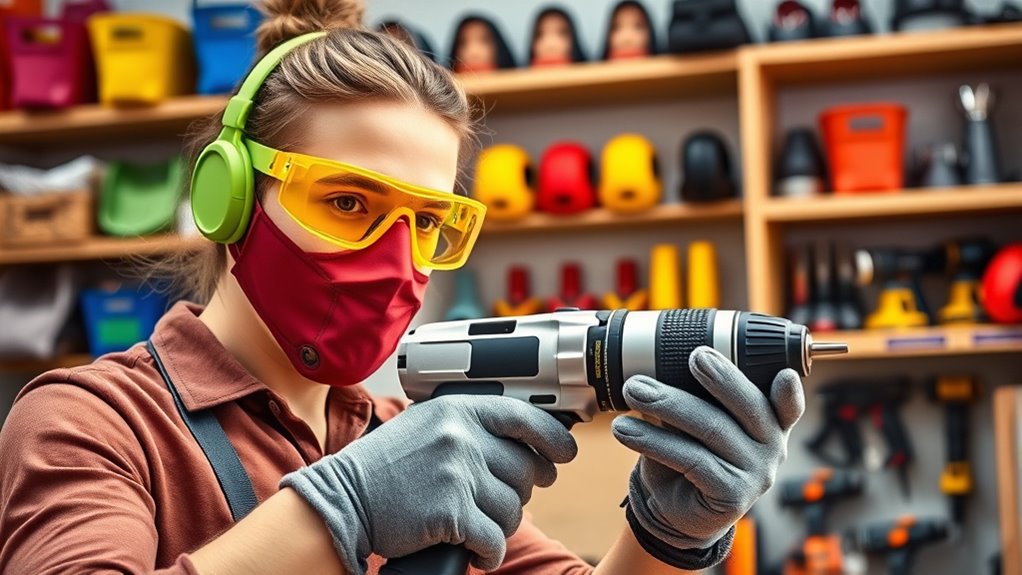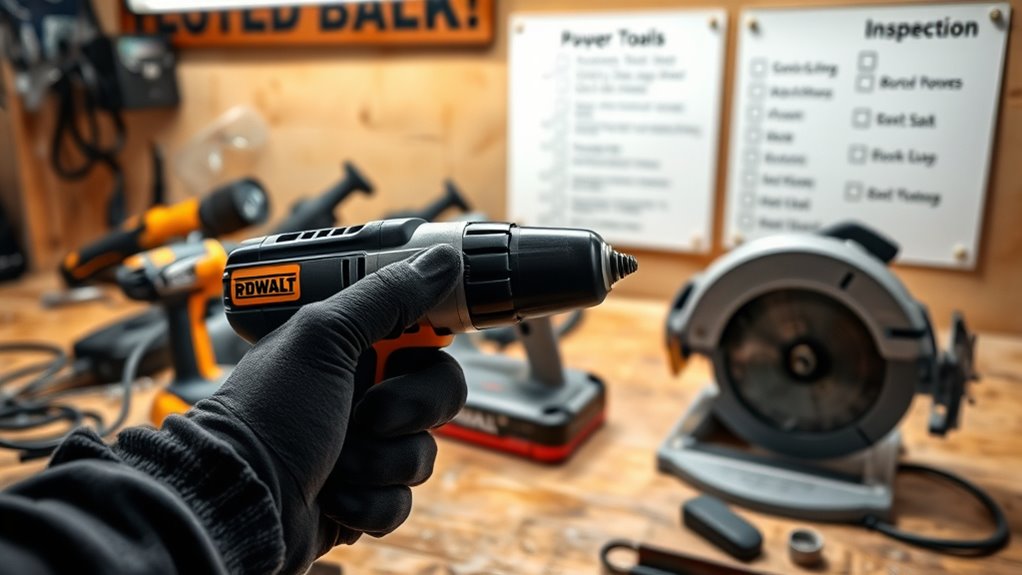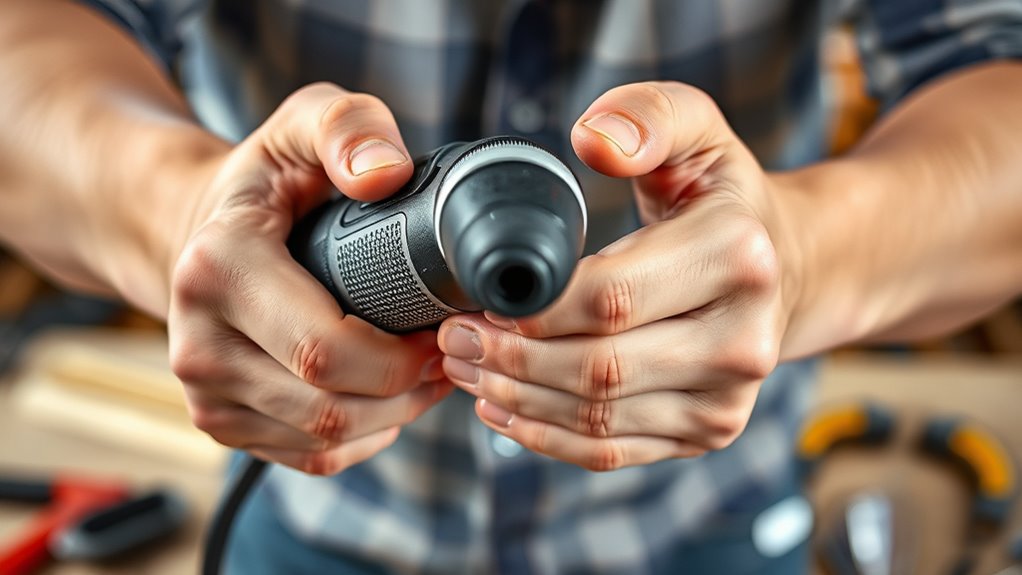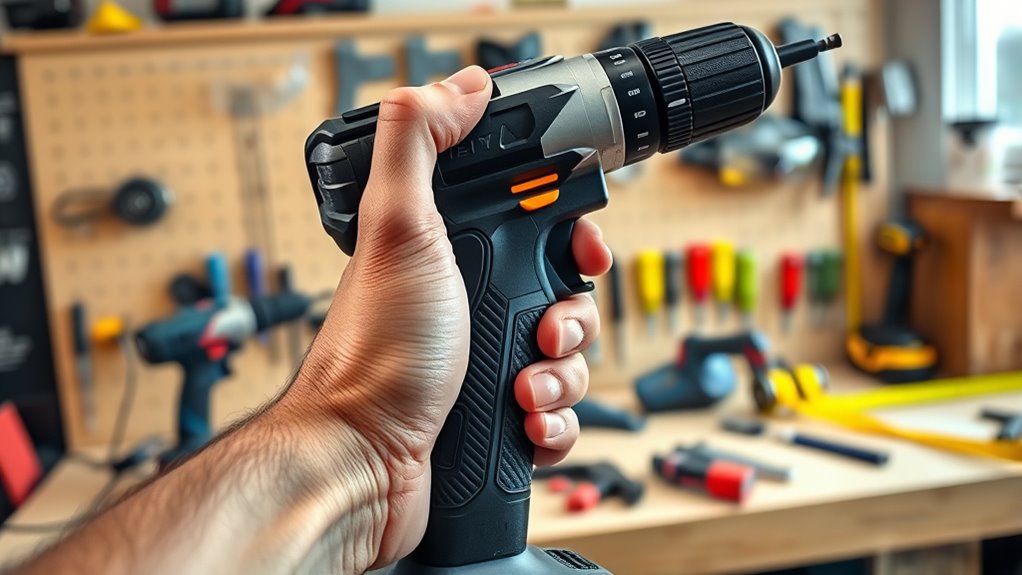To stay safe during your DIY craft projects, always wear appropriate safety gear like goggles, gloves, and ear protection, and inspect tools for damage before use. Keep your workspace organized, clear of debris, and make certain your power cords and batteries are in good condition. Understand your tools’ functions, use them properly, and secure workpieces firmly. For more tips on staying safe and avoiding accidents, keep exploring these essential safety practices.
Key Takeaways
- Always wear proper PPE, including goggles, gloves, and ear protection, and inspect tools for damage before use.
- Verify power sources, cords, and safety features to ensure tools operate correctly and safely.
- Keep your workspace organized, clean, and well-lit to prevent accidents and improve visibility.
- Use the correct blades, secure workpieces, and follow safe handling practices during cutting, sanding, and drilling.
- Maintain a first aid kit nearby and know emergency procedures for handling injuries effectively.
Selecting the Right Safety Gear

Choosing the right safety gear is essential to protect yourself when working with power tools. Personal protective equipment (PPE) is your first line of defense, so make sure to select items that fit well and suit your tasks. Safety goggles shield your eyes from flying debris, while ear protection prevents hearing damage. Gloves can protect your hands, but only if they’re appropriate for the specific tool and task. Additionally, consider the tool’s ergonomic design to reduce strain and improve control, which enhances safety. Comfortable, well-fitting PPE encourages consistent use, making your workspace safer. Always prioritize high-quality gear that meets safety standards. Properly chosen PPE, combined with awareness of your tools’ ergonomic features, minimizes risks and keeps you protected during every step of your DIY project. Being aware of best safety practices and how to select suitable gear further enhances your safety and efficiency. Moreover, understanding the importance of safety gear verification can help you avoid counterfeit or substandard equipment that may compromise your protection. Incorporating safe handling techniques can also significantly reduce the chance of accidents and injuries. Additionally, selecting PPE with appropriate material durability ensures long-lasting protection during demanding tasks. When you understand the fundamentals of power tool safety, you can better anticipate potential hazards and prevent accidents before they occur.
Inspecting Your Tools Before Use

Before using your power tool, take a moment to inspect it thoroughly. Check for any damage, guarantee the power source is secure, and test its functionality. Doing this helps prevent accidents and keeps your work safe and efficient. Additionally, understanding tuning options and potential modifications can enhance your overall project performance and safety. It’s also beneficial to review safety guidelines and proper handling techniques to ensure safe operation during your DIY projects. Regularly inspecting paint sprayer nozzles and accessories can prevent malfunctions and ensure consistent application quality. Recognizing the importance of self-awareness and emotional regulation can help manage stress and prevent impulsive actions that may lead to unsafe situations. Remember, inspirational quotes about fatherhood remind us of the importance of care and attention to detail, which applies just as much to power tool safety as to parenting.
Check for Damage
Have you ever considered how a quick inspection can prevent accidents? Before using your power tools, perform a damage assessment to identify any signs of tool wear or damage. Look for cracks, loose parts, frayed cords, or corrosion. Damaged tools can malfunction unexpectedly, risking injury or project failure. Check the blades, cords, switches, and housing for any visible defects. If you notice any damage, don’t use the tool until it’s repaired or replaced. Ensuring your tools are in good condition minimizes the risk of accidents caused by equipment failure. Remember, a thorough damage check is a simple step that keeps your workspace safe and your projects on track. Never ignore signs of wear—safety starts with proper inspection.
Verify Power Source
A quick check of your power source can prevent many accidents before you start working. Make certain your power source is appropriate for your tool and in good condition. Inspect cords for cuts, frays, or exposed wires that could compromise electrical safety. Confirm that plugs fit securely and aren’t damaged. Never use damaged cords or outlets, as they pose a risk of electrical shock or fire.
Before powering up, consider these safety tips:
- Use grounded outlets and proper extension cords
- Keep cords away from water or wet surfaces
- Avoid overloading circuits to prevent electrical hazards
Verifying your power source is a simple step but essential for safe DIY craft projects. It helps protect you from electrical accidents and ensures your tools operate properly.
Test Functionality
How can you guarantee your power tools are safe to use? The key is to test functionality before starting your project. Turn on the tool and observe its performance, making sure it runs smoothly without unusual noises or vibrations. Check that safety features, like switches or guards, operate correctly. If you’re using a cordless tool, ensure the battery holds a charge and powers the tool effectively. Testing functionality helps identify any issues that could compromise safety or tool performance during use. Don’t skip this step—taking a few moments to inspect your tools can prevent accidents and improve your work quality. Always address any irregularities before operating the tool, ensuring it’s in top condition for a safe, successful DIY project.
Proper Handling and Grip Techniques

To operate power tools safely and effectively, mastering proper handling and grip techniques is essential. Your grip strength and handling techniques directly impact control, safety, and precision. To optimize your technique, focus on these key points:
- Maintain a firm but relaxed grip to prevent fatigue and ensure control
- Keep your hands steady and close to the tool’s handles for better leverage
- Use both hands when possible to distribute force evenly and improve stability
- Incorporating expert voice actors into your training can help you develop better control and confidence with your voice, similar to mastering proper handling of power tools.
- Developing proper grip strength can enhance your overall control and reduce fatigue during extended use.
- Understanding AI-powered training tools can further improve your skills by providing personalized feedback and guidance.
- Practicing proper handling techniques can also minimize the risk of injuries, ensuring a safer experience during your DIY projects.
- Regular practice and safety awareness are vital to maintaining safe and effective power tool operation, especially for beginners.
Maintaining a Clean and Organized Workspace

Keeping your workspace clean and organized is essential for safe power tool use. Make sure your work surfaces are clear, tools are stored properly, and you follow a regular cleaning routine. These habits help prevent accidents and keep your workspace efficient. Additionally, being aware of the electric bike horsepower can help you understand the power of your tools and equipment, ensuring safe handling and operation. Incorporating safety protocols into your routine can further reduce risks and promote a safer environment. Staying informed about AI-driven solutions in healthcare can also inspire innovative safety measures and productivity improvements in your workspace. Regularly updating your knowledge about automation in business can help you adopt new safety features and efficiency practices. Developing a routine that includes workplace safety best practices can enhance overall safety and efficiency.
Clear Work Surfaces
A clean and organized workspace is vital for safe power tool operation. Keeping your work surface clear minimizes accidents and helps you focus. Regularly clear clutter to prevent tripping hazards and accidental tool activation. Make certain dust collection is effective, as dust buildup can obscure your view and pose health risks. Good workspace lighting is essential—bright, well-placed lights help you see fine details and avoid mistakes.
To maintain a safe environment, remember to:
- Remove unnecessary tools and debris from your work surface
- Set up proper dust collection systems to keep the area clean
- Use adequate lighting to illuminate your workspace clearly
Staying organized reduces distractions and keeps safety front and center during your DIY projects.
Proper Tool Storage
Proper tool storage is essential for maintaining a safe and organized workspace. When you keep your tools properly stored, you reduce the risk of accidents and make it easier to find what you need quickly. Use designated areas for tool storage and safety gear storage, preventing clutter that could cause trips or injuries. Invest in shelves, bins, or pegboards to keep tools accessible and secure. Label storage spaces to streamline your workflow. Here’s a quick guide:
| Tool Storage Area | Safety Gear Storage | Tips |
|---|---|---|
| Shelves or bins | Wall hooks or bins | Keep frequently used tools at eye level |
| Pegboards | Lockable cabinets | Regularly check for damage or wear |
| Drawers | Dedicated boxes | Store heavy tools on lower shelves |
Regular Cleaning Routine
To guarantee your workspace remains safe and efficient, establishing a regular cleaning routine is essential. Dust accumulation can clog vents and reduce power tool performance, so wipe down equipment after each use. Regularly check for debris on work surfaces and clear clutter to prevent accidents. Additionally, applying lubricant to your tools helps prevent rust and ensures smooth operation. Keep these tips in mind:
- Remove dust buildup from blades, vents, and switches
- Wipe down surfaces to maintain cleanliness and visibility
- Apply lubricant to moving parts to extend tool lifespan
Understanding Power Tool Functions and Settings

Understanding how power tool functions and settings work is essential for safe and effective operation. Knowing how to make proper setting adjustments ensures you control the tool correctly, reducing accidents. Most power tools have adjustable features like speed, torque, or depth, which influence your work quality. Familiarize yourself with the specific functions of your tools before use. Use this table to grasp the importance of setting adjustments:
| Power Tool Function | Purpose |
|---|---|
| Speed Control | Adjusts power output for precision |
| Torque Settings | Prevents over-tightening or damage |
| Depth Adjustment | Controls how deep the cut or drill |
| Mode Selection | Switches between cutting, sanding, or drilling |
| Safety Lock | Prevents accidental activation |
Mastering these functions helps you operate safely and efficiently. Additionally, understanding lifestyle aspects like workspace organization and ergonomic setup can further enhance your safety and productivity when working on DIY projects.
Safe Cutting, Sanding, and Drilling Practices

When you cut, sand, or drill, following safe practices is essential to prevent accidents and guarantee quality results. Proper blade selection ensures clean cuts and reduces kickback risks. Always choose the right blade for your material and task. Use dust control measures like vacuum attachments or masks to minimize inhalation and keep your workspace clean. Keep your tools well-maintained and sharp to prevent slips and uneven finishes. Secure your workpiece firmly to avoid movement during operation. Wear safety goggles and gloves for added protection. Regularly inspect your tools to catch any damage or wear. Remember, safety isn’t just about equipment—it’s about your focus, preparation, and awareness. Prioritize these practices to craft safely and achieve professional results confidently.
Managing Power Cord and Battery Safety

Managing power cord and battery safety is essential for preventing accidents and ensuring your tools work correctly. Proper cord management keeps your workspace organized and reduces trip hazards. Always inspect cords for damage before use and avoid overstretching or pinching them. For battery safety, only use chargers recommended by the manufacturer and store batteries in a cool, dry place away from flammable materials. Never expose batteries to extreme heat or puncture them, which could cause leaks or fires. Here’s a quick guide:
| Aspect | Tip |
|---|---|
| Cord Management | Keep cords untangled and away from walkways |
| Battery Safety | Use original chargers; store safely |
| Inspection | Regularly check for frays or damage |
| Storage | Store batteries in cool, dry areas |
| Usage | Avoid overstretching cords or exposing batteries to heat |
Responding Effectively to Accidents and Emergencies

Being prepared to respond quickly and effectively can make all the difference during an accident or emergency involving power tools. Knowing emergency response actions and first aid procedures guarantees you can act swiftly to minimize damage. Keep a well-stocked first aid kit nearby and familiarize yourself with basic first aid procedures. In case of an injury, remember to:
Being prepared to respond quickly can save lives and prevent complications during power tool accidents.
- Call emergency services immediately if the situation is severe
- Stop the power tool and remove it from the area
- Provide first aid, such as applying pressure to bleeding wounds or immobilizing injuries
Quick response can prevent complications and save lives. Stay calm, assess the situation carefully, and follow your emergency response plan. Being prepared gives you confidence to handle unexpected accidents effectively.
Frequently Asked Questions
How Often Should I Replace or Upgrade My Power Tools for Safety?
You should replace or upgrade your power tools based on their tool maintenance and replacement frequency. Regularly inspect your tools for damage, wear, or loose parts, and follow the manufacturer’s recommendations. If you notice decreased performance, unusual noises, or safety hazards, it’s time to upgrade or replace. Staying proactive with maintenance ensures your tools stay safe, effective, and reliable, minimizing risks during your DIY craft projects.
Are There Specific Safety Certifications I Should Look for in Tools?
Imagine your tools as trusted stewards, guiding your craft safely. Look for safety certifications like UL, CSA, or CE, which act as badges of honor, ensuring they meet strict tool standards. These certifications are your shield against hazards, confirming your tools are safe and reliable. Always choose tools with recognized safety labels, so your creative journey stays secure, and your craftsmanship remains strong and steady.
What Are the Most Common Causes of Power Tool Accidents?
You should know that the most common causes of power tool accidents include improper power tool maintenance, like dull blades or loose parts, and user errors such as not wearing safety gear or rushing. To prevent accidents, always inspect your tools before use, follow safety guidelines, and stay alert. This helps guarantee accident prevention and keeps your DIY projects safe and enjoyable.
How Can I Prevent Electrical Hazards During DIY Projects?
To prevent electrical hazards, you should follow proper grounding practices, ensuring your tools are grounded correctly to avoid shocks. Practice good cord management by keeping cords untangled, out of walkways, and away from water or sharp edges. Regularly inspect cords for damage, replace frayed or broken ones, and avoid overloading circuits. By grounding safely, managing cords carefully, and staying vigilant, you protect yourself from electrical hazards during your DIY projects.
What Safety Measures Should I Take When Working at Heights With Power Tools?
When working at heights with power tools, you should always harness safety gear to prevent falls. Make sure you have a proper ladder setup—stable, on level ground, and at the correct angle. Wear a harness or fall arrest system if necessary. Keep your hands free, maintain three points of contact, and stay alert. These safety measures safeguard you and ensure your project stays safe and successful.
Conclusion
By following these safety tips, you’ll turn your DIY projects into masterpieces, not mishaps. Think of your workspace as a fortress where accidents have no place, and your skills shine brighter than a diamond. Stay alert, handle tools with care, and always prioritize safety—you’re the hero of your craft story. With a little caution, you’ll create stunning projects without risking your well-being. Remember, safety isn’t just a rule; it’s your best tool for success.









